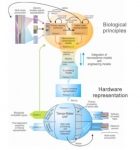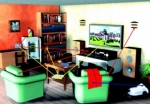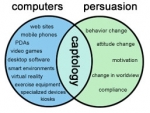Feb 24, 2007
RFID Powder Developed By Hitachi

Hitachi researchers have developed a new micro-miniaturized radio frequency identification (RFID) chip that is 64 times smaller than their currently available 0.4 x 0.4 mm mu-chips.
At 5 microns thick, the RFID chips can more easily be embedded in sheets of paper, meaning they can be used in paper currency, gift certificates and identification
15:23 Posted in Pervasive computing | Permalink | Comments (0) | Tags: rfid, ambient intelligence
Dec 15, 2006
Intelligent rooms: RoomRender
Via Pink Tentacle

SGI Japan has developed a system that can control the electronics, appliances and hardware in a room based on the spoken commands and emotions of the room’s occupants. RoomRender relies on AmiVoice voice recognition technology (developed by Advanced Media) to recognize and analyze spoken commands, enabling the room to close the blinds, turn on the heater, etc. as instructed.
Read the full story on Pink Tentacle
00:11 Posted in Pervasive computing | Permalink | Comments (0) | Tags: ambient intelligence, emotional computing, pervasive technology, persuasive technology
Dec 06, 2006
Interactive pillows
re-blogged from infoaesthetics

a pair of interactive pillows designed to enhance long-distance communication. users can interact with a pillow in a specific location, which activate dynamic textile patterns in a pillow located elsewhere: by leaning against, touching, or hugging a pillow, the pattern on the other pillow activates & glows dynamically. these ambient patterns expand the vocabulary for remote communication through tangible & aesthetic interactions.
00:49 Posted in Pervasive computing | Permalink | Comments (0) | Tags: ambient intelligence
Oct 30, 2006
IMAI 2007
Salt Lake City, July 16-22, 2007

From the conference website
In the last few years we have witnessed an explosive growth of multimedia computing, ambient intelligent (AmI), pervasive and ubiquitous computing. The few key technologies interact in an interesting and yet useful way, bringing profound impact and revolution. The revolution is transforming the way people live, work, and interact with each other, and is impacting the way business, government services, education, entertainment and health care are operating.
IMAI 2007 is the continuous of IMMCN (International Conference on Intelligent Multimedia Computing and Networking) series running since the beginning of this century. IMAI 2007 seeks the contribution of high quality papers addressing various aspects of multimedia and ambient intelligence, in particular the techniques that lead the merging of both intelligences, for presentation at the conference and publication in the JCIS(Joint Conference on Information Science) proceeding. For the topics of interest, go to the conference website
The paper should follow the JCIS 2007 ( http://www.jcis.org/jcis2007/ ) paper submission guideline. Seleted high quality papers will be published in Information Science journal.
15:05 Posted in Pervasive computing, Positive Technology events | Permalink | Comments (0) | Tags: ambient intelligence, pervasive computing, positive technology events
Sep 30, 2006
Perimeters, Boundaries, and Borders
|
Artists, architects, designers, and other practitioners are constantly fashioning new forms and challenging disciplinary boundaries as they employ techniques such as rapid prototyping and generative processes. In the exhibition Perimeters, Boundaries, and Borders, at Lancaster, UK's Citylab, organizers Fast-uk and Folly explore the range of objects, buildings, and products being conceptualized with the aid of digital technologies. Aoife Ludlow's 'Remember to Forget?' is a series of jewelry designs that envisioned accessories incorporating RFID tags that allow the wearer to record information and emotions associated with those special items that we put on daily. Tavs Jorgensen uses a data glove in his 'Motion in Form' project. After gesturing around an object, data collected by the glove is given physical shape using CNC (Computer Numerical Control) milling, creating representations of the movements in materials such as glass or ceramics. Addressing traces of a different sort is Cylcone.soc, a data mapping piece by Gavin Bailey and Tom Corby. These works and many more examples from the frontiers of art and design are on view until October 21st." Rhizome News. |
19:39 Posted in Emotional computing, Pervasive computing | Permalink | Comments (0) | Tags: ambient intelligence, emotional computing, pervasive technology, persuasive technology
Jul 18, 2006
MODIE: Modelling and Designing User Assistance in Intelligent Environments
Themes & Topics
We are interested in models, principles and methodologies, which guide the designer of an intelligent environment in the early stages of the development process, such as task and requirements analysis and conceptual design. We are looking for contributions, which will help the designer of user assistance systems to address the following questions:
- Which user activities and tasks require assistance?
- How to map an activity model into interactions with artifacts?
- How should the designer choose the best sensing and interaction technologies for a scenario?
- Which mobile or wearable personal devices can be employed?
- How should multiple users with concurrent activities be supported?
- How should the current state of the user assistance system be represented, especially when dealing with multiple tasks?
The intention of the workshop is to share experiences and perspectives on user assistance in intelligent environments from the different view-points of developers, designers, ethnographers and cognitive scientists. Each participant will give a short presentation about their contribution. The second half of the workshop will be focused on the discussion of key topics:
- How to unify the complementary concepts of public and personal devices
- How to model user activity (terminology, structure, notation)
- Suggest a terminology for intelligent Environments
- How tools can support the modelling and designing of user assistance
- What the problems of applying traditional software engineering methodologies are
- Are there principles that can be generalized for the design of IEs?
Intended Participants
We encourage researchers from the following disciplines to contribute position papers (2-6 pages) and knowledge to the discussion:
- Computer Scientists (in the fields of Mobile HCI and Intelligent Environments): contribute experiences with working prototypes, discuss technical issues.
- Designers: contribute new paradigms and concepts, discuss existing environments and current solutions to present information to the user, how might the future look like?
- Ethnographers: contribute an analysis of user activities and problems in current environments, discuss application areas for Intelligent Environments.
- Cognitive Scientists: contribute design principles for Intelligent Environments based on their knowledge about the limited resources of the human processor, discussion of pros and cons of interaction paradigms, concepts and technologies.
Workshop Format
MODIE will be a full day workshop. Each participant will give a short presentation on their position and experience in dealing with one or several of the workshop topics. It is assumed that the participants are already familiar with the position papers, which will be available as online proceedings prior to the workshop. In the afternoon, the participants will split into small groups and discuss interesting research topics. Afterwards we will present and discuss their results.
Important Dates
---------------
Submission Deadline July 10, 2006
Acceptance Notification July 13, 2006
Workshop Date September 12, 2006
01:12 Posted in Call for papers | Permalink | Comments (0) | Tags: ambient intelligence
Feb 19, 2006
Ambient Intelligence: algorithms, methods and applications
9, 10 and 11 October 2006, at the 10th International Conference on Knowledge-Based & Intelligent Information & Engineering Systems:
This special session will focus on Artificial Intelligence techniques, essential for implementing AmI systems, complementing past workshops, which are generally oriented towards computer vision for the AmI paradigm.
Areas of interest include, but are not limited to:
- multi-agent methods,
- multi-sensor fusion,
- intelligent human-environment interaction,
- advanced human-computer interaction,
- conventional and embedded robotics solutions,
- ambient representation and innovative sensors
Notification of acceptance: 1 April 2006 Final papers to be received by: 1 May 2006
22:55 Posted in Pervasive computing | Permalink | Comments (0) | Tags: Positive Technology, ambient intelligence
Feb 14, 2006
Bio-inspired intelligent machines
Via Smart Mobs
The goal of the EU-funded SenseMaker project is to develop electronic architectures that embody the features of living perceptual systems and are able to merge sensory information obtained through different sensory modalities, into a unified perceptual representation of the environment. The architectural design of the SenseMaker machine will be based on biological principles of sensory receptor and nervous system function, inspired by experimental studies of several different sensory modalities.

The system will include higher cognitive levels modelled on psychophysical research paradigms, whose function will be to implement dynamic rules of cross-modal integration, activity and time-dependent algorithms for internal prediction, goal directed attention, and transitions between dominant or convergent sensory modalities according to changing environmental parameters.
11:40 Posted in Pervasive computing | Permalink | Comments (0) | Tags: Ambient intelligence
Jan 12, 2006
Your Room as Browser
 From the website:
From the website:In effect, your whole room becomes a 'browser' that brings the experience to life. For example, PML-enabled lights add to the experience by getting brighter or dimmer, or changing colour. A PML-enabled hi-fi provides an appropriate soundscape. Almost any device can be PML-enabled: the possibilities are only limited by the imaginations of their manufacturers. Suppose a room is rendering an experience described as 'warm and sunny': the lights, the TV, the central heating, the electronically controlled blinds and (a little further into the future) even the ceiling, walls and floor coverings could all contribute to creating it.
10:19 Posted in Pervasive computing | Permalink | Comments (0) | Tags: Positive Technology, Ambient intelligence
Oct 13, 2005
Pervasive Health Conference
Pervasive Healthcare Conference 2006 will be held in Innsbruck, Austria (dates to be defined). Pervasive Healthcare is emerging both as a solution to many existing healthcare problems such as significant number of medical errors, considerable stress on healthcare providers, and partial coverage of healthcare services in rural and underserved areas worldwide, and as an opportunity to provide better healthcare services to an increasing number of people using limited financial and human resources.  Pervasive healthcare can be defined as healthcare to anyone, anytime, and anywhere by removing locational, time and other restraints while increasing both the coverage and quality of healthcare.
Pervasive healthcare can be defined as healthcare to anyone, anytime, and anywhere by removing locational, time and other restraints while increasing both the coverage and quality of healthcare.
Conference topics include, but are not limited to: technologies situated "on the patient", technologies situated "in the environment", medical aspects of pervasive healthcare, and management of pervasive healthcare.
For more information visit the conference website
![]() Tags: pervasive healthcare
Tags: pervasive healthcare
11:50 Posted in Pervasive computing | Permalink | Comments (0) | Tags: Positive Technology, Ambient intelligence
Jul 27, 2005
Ambient Experience for children undergoing MRI scan
Via Near Near Future
Ambient Experience for Healthcare is a program designed to lessen patient anxiety and claustrophobic effects of an MRI scan through the use of a multimedia environment. As soon as patients enter the MRI department, they are automatically identified by the system and the environment changes to match their personal features. Lighting and ambience of the room, as well as music and projections, can be adapted to match the specific needs of patients.

Patients can choose from four themes, each geared for different tastes and age groups; aquatic, space, fly-through and a default lava lamp type ambience. RFID-encoded cards corresponding to the theme chosen by patients cause the lighting and wall/ceiling projection to change in the exam room as they enter.
Ambient Experience was recently awarded a gold medal in the annual Industrial Design Excellence Award
10:45 Posted in Pervasive computing | Permalink | Comments (0) | Tags: Positive Technology, Ambient intelligence
Jul 21, 2005
Ubiquitous computing for cognitive decline
Cognitive decline is one of the most taxing health problems in terms of both its relation to elders' overall functioning and the cost of care. The loss of their abilities to use everything from a coffee maker to a computer may lead to social isolation, a decreased motivation, and increasing dependence on skilled support for assistance in routine activities. Prevention, early detection, and assistance for cognitive decline may be a useful application for ubiquitous computing technologies.
Ubicomp solutions typically involve multiple invisible devices embedded in the physical environment, all connected together to respond in transparent ways to the users in the context of everyday events. Ubicomp may match the challenge of providing elders pervasive support throughout the home, and adaptable levels of support.
For example, Intel's Proactive Health Research initiative is exploring location and activity tracking technologies to support elders' indipendence and safety monitoring by caregivers. The programme also aims at investigating technologies that facilitate social connectedness and continuation of meaningful activities.
More to explore
Free full-text publications on pervasive computing
16:05 Posted in Pervasive computing | Permalink | Comments (0) | Tags: Positive Technology, Ambient intelligence
Mar 29, 2005
Captology: The science of Persuasive Technology
Can computers change what you think and do? Can they motivate you to stop smoking, persuade you to buy insurance, or convince you to join the Army?
The Stanford Persuasive Technology Lab, founded by BJ Fogg, an experimental psychologist, is trying to answer these questions. The lab creates insight into how computing products -- from websites to mobile phone software -- can be designed to change what people believe and what they do.
Like human persuaders, persuasive interactive technologies can bring about positive changes in many domains, including health, business, safety, and education. With such ends in mind, we are creating a body of expertise in the design, theory, and analysis of persuasive technologies, an area called "captology."
This is how Fogg describes the key concepts of his vision:
"Captology is the study of computers as persuasive technologies. This includes the design, research, and analysis of interactive computing products created for the purpose of changing people's attitudes or behaviors. As the graphic shows, captology describes the area where computing technology and persuasion overlap.

In the last few years we've seen this area grow quickly. Each week more computing products are designed to change what users think and do. We expect this trend to continue, especially as mobile phones become more capable of running third-party software applications.

We've identified over 100 uses for persuasive technology. Hundreds of other uses exist. Whenever there is a need to change what people believe or how they behave, persuasive technology may very well play a role"
More to explore
The web site of the Lab: http://captology.stanford.edu/
Fogg's book "Persuasive Technology"
18:15 Posted in Pervasive computing | Permalink | Comments (0) | Tags: Positive Technology, Ambient intelligence
Mar 23, 2005
Considerate computing
Ambient Intelligence will radically change how people interact with technology. In AmI, people will be surrounded by a multitude of interconnected embedded systems. These devices will be able to locate and recognize objects and people, as well as people’s intentions.
Following this view, AmI researchers are beginning to design computing devices that adapt the volume and timing of their communications to the cognitive needs of user. Such systems with a deep understanding of user attention have been referred to as Attentive User Interfaces

In AmI spaces these systems will proactively undertake speculative or anticipatory actions to hide the overall system complexity, by delivering to the users only information which is rich with meanings and contexts and provide stable functionality whenever requested
This article by Wayt Gibbs, recently published on Scientific American, show how engineers are testing computers, phones and cars that sense when you are busy and spare you from distractions...
More to explore
Attentive User Interfaces. Special section. Edited by Roel Vertegaal in Communications of the ACM, Vol. 46, No. 3, pages 30–72; March 2003.
Learning and Reasoning about Interruption. Eric Horvitz and Johnson Apacible. Proceedings of the Fifth International Conference on Multimodal Interfaces, November 2003. Proceedings of the International Workshop on Progress and Future Directions of Adaptive Driver Assistance Research. Washington, D.C., May 2004. Available online at www.volpe.dot.gov/opsad/saveit/
A variety of relevant technical articles are available online at http://interruptions.net
11:15 Posted in Pervasive computing | Permalink | Comments (0) | Tags: Positive Technology, Ambient intelligence
Jan 10, 2005
Experience Design: Erik Davis' vision
Experience Design And the Design of Experience
by Erik Davis
This piece appeard in Arcadia: Writings on Theology and Technology (Australia, 2001)
There is no creation ex nihilo. We always work from pre-existing material, both literal substances (wood, a language, the resonance of strings and reeds) and the existing cultural organization of those materials within history, tradition, and contemporary networks of influence. So as we survey the expanding and converging landscape of electronic, virtual, and immersive production, we might ask ourselves: what material is being worked here? Is it simply new organizations of photons, sound waves, and haptic cues? Or does the "holistic" fusion of different media and the construction of more immersive technologies actually suggest another, perhaps more fundamental material?
I’d wager that the new material is indeed rather fundamental: human experience itself. Of course, "human experience" is a vague and historically loaded concept, and a thorough hashing out of the term would require, at the very least, lengthy excursions into Jamesian pragmatism, psychobiology, and Buddhist phenomenology. But for the moment let’s just think of human experience as the phenomenal unfolding of awareness in real time, a movement which tugs against the network of concepts and significations while tending toward the condition of more direct sensation or intuitive perception. In other words, experience may not be able to escape the prisonhouse of language, but it willingly sticks its nose out the barred window and inhales.
Many semiotic and structuralist arguments suggest that we are creatures of language, that nothing, either sensations or intuitions, escapes the domain of signs. But one can just as easily argue that everything that arises in consciousness is experience — that memory, analysis, and reflection all arise in the phenomenal stream, the loops and twists, of James’ "stream of consciousness." As a compromise between these two positions, imagine that you possess an analog Consciousness slider that runs from the nearly totally linguistic on one side to the pure intensities of sensation on the other. While avoiding a strict divide, your thought gizmo allows you to make a gradual though clear distinction between meaning and sensation.
Take the example of a rollercoaster. Obviously roller-coasters exist within a network of symbolic associations. But the act of subjectively submitting your bodymind to a rollercoaster ride, and undergoing the resulting thrills of adrenaline, fear, and gut-fluttering sensation, cannot be directly assimilated to the network of significations that constitute the meaning of rollercoasters. The same point can be made about recreational drugs. Obviously the drug experience is mediated by culture, by expectations, rituals, and social stories about the meaning and value of certain compounds. But we are sticking our heads in the sand if we insist that the evident physiological changes induced by drugs do not correspond with real psychological changes, not only in the content of subjective experience (its images, pleasure fluxes and meanings), but in the more fundamental cognitive parameters which structure experience in the first place.
At the same time, these non-semiotic elements of experience can also function as passageways to new regimes of signs. Fans of psychedelics often find themselves plunging into incoherent or abstract deformations of perception and sensation, only to "break through" into very strange, but nonetheless solid and coherent, worlds of meaning. Immersive works of art or entertainment are also rarely content to simply produce a new range of sensations. Instead, they often function as portals into "other worlds." Following a similar development, the rollercoaster grows into themed adventure rides like Universal Studio’s Back to the Future attraction. These other worlds, of course, are composed of the same sorts of signs that make up our shared human construct — indeed, they often detach those signs from conventional reality, recombining or morphing them within the more malleable zone of the virtual. But in order to successfully boot up these new semiotic universes within a users’ consciousness, the media technology must directly engage the machinery of human perception (proprioception, 3d audio, etc) on a "subliminal" level. In other words, immersive worlds are constructed on a platform of rejiggered experience.
And so we enter the era of what I’m calling Experience Design. A quick scan of our sociocultural landscape suggests that, in terms of artistic practices, mass entertainment, sports, and emerging technologies of pleasure, productive forces are increasingly targeting experience itself — that evanescent flux of sensation and perception that is, in some sense, all we have and all we are.
Let’s begin with the rise of the so-called "experience economy." On one level, this describes an apparent shift within the consumption patters of the younger, more technologically savvy elite, a shift away from the hoarding of material goods and status symbols to the hoarding of novel, exciting, and challenging experiences. (Dennis Tito’s 20 million-dollar space holiday on MIR is the paragon here). The experience economy of the super-rich also dovetails with broader cultural trends, including the dramatic intensification of tourism over the last few decades — a process which offers us increasingly specialized, adventurous, and exotic packages (guzzling ayahuasca with Peruvian shamans, caving in Belize, visiting real live monks in Bhutan). We have also seen a heightened interest in technologically-mediated outdoor activities like rock climbing or wind surfing, along with the rise of "extreme sports," which have little to do with sports as contest and much to do with the production of subjective intensity. The extreme example here is the Bungie jump, which requires neither skill nor exertion beyond the passive willingness to undergo the death-defying neurotransmitter and adrenaline rush that hits the nervous system.
The turn towards increasingly raw experience also marks a number of developments within media and entertainment, including the often-remarked descent to the lowest common denominator of sex, violence and the gross-out stunts of MTV’s Jackass ("Don’t try this at home!"). Over the last ten or fifteen years we have also seen the rise of a new kind of film, one which features amazing special effects, but which otherwise sucks. Whether or not we judge such films to be good, or even worthwhile, depends on how much we accept the new regime of special effects as a semi-autonomous component of cinema whose art is largely devoted to stimulating immediate sensations and visceral — rather than symbolic or narrative — emotion. A similar logic comes to the fore in many computer games and mass applications of virtual reality technologies in amusement parks and arcades, all of which strive for the quality of "immersion" — which is often just another word for simulated experience. Meanwhile, the language of "experience" has become thoroughly integrated into multimedia design, even in the relatively low-bandwidth tricks and offerings that commercial websites use to capture sticky eyeballs.
***
In the musical sphere, we can see a similar shift in the rise of raves, where intense lights, sounds, and projection screens combine to create a visceral, often collective experience of intensity and atmosphere. These effects (and affects) differ markedly from the more traditional identifications available through even the most Dionysian rock concerts. Another crucial ingredient to the rave experience is drugs. As Simon Reynolds has argued, many elements of electronic dance music, including non-sonic elements like light sticks and Vicks Vap-o-rub inhalers, emerged because of the particular effects they produce in a suitably tweaked mind. In fact, psychoactive drugs are in some ways the ultimate "technology of experience," and establish a basic model for Experience Design. The rapid advances in psycho-pharmacology, both corporate and underground, have given rise to a flood of consciousness-modifying substances which promise to both suppress unwanted dimensions of human experience (depression, anxiety) and open up novel spaces of perceptual and cognitive effects to immediate exploration.
Obviously, a startlingly broad range of phenomena can be placed under the umbrella of Experience Design, and such breadth is often suspicious. But despite a number of crucial problems that are overlooked in this acute generalization, it seems crucial to recognize and emphasize the continuity, rather than the divergence, between contemporary practices that target the human sensorium. Across the fields of art, architecture, media, music, pharmacology, even spirituality, we are moving towards the intentional and multi-dimensional stimulation and production of a complex range of increasingly immediate human responses, including the direct induction of classic "altered states of consciousness." These responses extend far beyond (and below) the traditional object of communication: the conscious human subject conceived as a rational agent and a reader of meanings. In other words, as science, pharmacology, and media technology deepen their understanding of how the human nervous system joins with the ever mercurial psyche to produce a lived sense of reality, these knowledges are becoming integrated into the engines of cultural production. To put it crudely, our cultural technologies are becoming less like books and songs, and more like rollercoasters or drugs.
Media art, with its connections to both alternative culture and critical theory, is curiously arrayed when it comes to Experience Design. On the one hand, its theoretical savvy frees it from the traditional notion of the subject as an autonomous agent of meaning, while also increasing the willingness to play with the construction of subjectivity. Yet many artists, writers and theorists remain queasy about the more technoscientific knowledges and practices involved in understanding and producing human subjectivity within the increasingly technical domain of psychology. This reflexively critical response to technoscientific discourses is mirrored in a similarly pervasive set of responses to spiritual or ritual discourses, which also fundamentally engage experience and the production of altered states of consciousness. While artists are becoming more overtly concerned with bioscience and spirituality alike, both of these flinches continue to result in art which stresses critical distance over the direct mobilization of effects and novel zones of becoming. This distance is valuable, but insufficient. However legitimate, skepticism and distrust of hard psychology, neural science, and psychobiology should not cut the (post)humanistic world off from direct engagement with the proliferating technologies of subjectivity.
For one thing, many other sectors of society are perfectly happy to employ these same tools to far more chilling ends. Advertising and marketing are only the most obvious examples on what I would call the right wing of Experience Design. ("Black magic" would perhaps be a more appropriate term, but I will leave the occult dimension of Experience Design aside for now). Here the target is often demonstrably irrational: an instinctive, un-self-aware subject whose inchoate fears and desires are organized around commodities or institutions. Though one must always beware of excessive fears over "subliminal" advertising, mallrats with sensitive noses will also recognize the pine and spice scents pumped into malls around Christmas time. Some slot machines are now equipped with high-tech smell emitters because certain scents have proven to keep individuals at the machines longer. Whether or not these cues are culturally determined is beside the point. What’s important is that at the moment, these stimulants aim for a technical zone of influence below "propaganda," which is still linked explicitly to a field of meanings. Instead they directly attack the limbic system, drawing the subject into a deeper, more immersive activity. As the West embarks on a Shadow War against terrorism, the tools of propaganda and psychic management alike can only proliferate.
***
By embracing the tools of Experience Design, media artists have and can continue to critique our expanding technosphere while also probing its capacity for beauty, pleasure, and novel perceptions -- even wisdom. Artists are uniquely placed to interrogate the production of technological experience, and to question the dominant experiences which are being engineered and renormalized by massive commercial engines of subjectivity. But this critical function must be coupled with experiment, with the willingness to creatively participate in the larger cultural process of re-engineering subjectivity, of pushing the envelope of experience. This is not necessarily a matter of becoming high tech -- relatively low-tech artists like Gary Hill and Bill Viola have made great strides in this direction. But it is a matter of directly engaging, not simply the new technologies, but the underlying technical "material" of subjectivity itself.
Finally, I believe this turn towards experience, in art and technology, is related to the growing embrace of the discourses and practices of spirituality. Whether or not it is defined or encountered within the context of faith traditions or not, "spirituality" largely emphasizes the use of subtle "psychological" techniques and practices to open up and transform our existential, personal, subjective encounter with the world and the self. At its best, the global turn towards meditation, yoga, healing prayer, trance dancing, and practices of loving-kindness reflects a search for a higher tone of experience itself, not a hunger for new consoling beliefs. The secular spirituality of self-help books, brain machines, and leadership seminars can also be seen as a species of "Experience Design" in that it emphasizes changing, or reprogramming, your direct experience of your self in the world. However, here the underlying intentions — which in some sense make or break spiritual aspiration — often leave much to be desired.
Media artists are uniquely placed to explore this emerging world of spirituality without falling into the dogmatic or New Age traps that swallow up so many true believers. Altered states of consciousness are real, and as our media technologies get better at drawing us in and out of them, artists and other non-coercive proponents of the human spirit (or whatever you want to call it) need to become familiar with these states, not simply as a source of inspiration, but as modes of expression, communication, and confrontation itself. By recognizing that the material that we are now focused on is not technology but human experience itself, then we take a step closer to that strange plateau where our inner lives unfold into an almost collective surface of shared sensation and reframed perception — a surface on which we may feel exposed and vulnerable, but beginning to awake.
16:10 Posted in Emotional computing | Permalink | Comments (0) | Tags: Positive Technology, Ambient intelligence
Dec 09, 2004
Optimal Experience & Ambient Intelligence

In the chapter that I have recently published in the book "Ambient Intelligence", I present a framework to evaluate user’s experience in AmI systems that stresses the role of attention in actively selecting information from the digital environment. Being a limited resource, attention forces the individual to focus on a restricted number of environmental or internal stimuli per time unit. Therefore, each individual effectively perceives only a small part of the available information. This form of psychological selection is driven a positive, complex and rewarding state of consciousness, called flow, or optimal experience. Starting from these premises, in the second part of the chapter I explain how optimal user experience in AmI systems may be assessed. In particular, I describe the Experience Sampling Method, a procedure that has been effectively used in various applied research domains.
20:10 Posted in Pervasive computing | Permalink | Comments (0) | Tags: Positive Technology, Ambient intelligence







